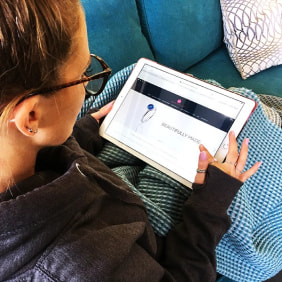How to Build a Memorial Website
Building a website can be difficult and stressful at the best of times, but when you are facing the death of a loved one and tasked with setting up a website in their memory, it can be even more difficult to navigate.
You want to make sure it’s perfect and provides a touching memory for your loved one, but building websites is difficult and requires some technical knowledge. Thankfully, there are platforms you can choose that will make it much easier and stress-free. If you’re trying to set up a memorial website for a loved one, read on to discover our top tips.
What is a memorial website?
A memorial website is simply a website created to honour the memory of someone who has passed away. It might be used to share photographs of the person, or it could be used to highlight their art or life’s work. For example, if you are honouring a well-known scientist, you might want to share information about their research and news developments about projects they have worked on. In short, a memorial website can be anything you want it to be.
Who needs a memorial website?
A memorial website is a great choice for those who might have moved around a lot and don’t have all of their loved ones in one place. This means that those who were closest to them might never have met one another. As such, the memorial website can be a helpful tool for those who are grieving to find and connect with those who share their grief - even when you can't be together.
Anyone can set up a memorial website for a loved one and there are no rules about who should or shouldn’t have one.

Can I use Facebook?
If you inform Facebook that an individual has passed away, it is their current policy to memorialise their Facebook page. This means that it will no longer appear in birthday reminders or suggestions for people you may know. However, this isn’t always the best option for a memorial website.
This is the current Facebook policy, and this could change in the future. Since the owner of the account is no longer with us, policy in the future could be to delete the account. It is far better to build your memorial website on a platform that you have complete control over. This is why we recommend a memorial website.
How to Build a Memorial Website
If you’re ready to set up your memorial website, follow these simple steps. The process shouldn’t take very long and will provide a lifetime of comfort to those impacted by the loss in this individual.
Choose a platform
The first step to setting up your memorial website is to choose the right platform for your needs. Platforms include sites like WordPress, Wix, Squarespace or specialist platforms like MuchLoved. A general platform will offer the most flexibility and will allow you to do exactly what you want with your website.
If you choose a self-hosted WordPress website, you will need to pay for your own hosting. Thankfully, if you search for “WordPress hosting” on Google, you will find lots of companies offering easy hosting packages. With this method, you will pay a monthly hosting fee, plus the cost of your domain name. Other platforms like Wix and Squarespace will offer free but limited versions, or you can pay a monthly fee.

Choose a template
The platform is just the place where your website content will be hosted. Next, you need to choose the look and feel of your memorial website. There will be lots of different free templates available, so you don’t have to worry about hiring a developer to build your website. You can change your template at any time, but this may change the way your website appears, so it’s a good idea to pick your website template before you go any further.
There are plenty of free templates available from WordPress, Wix and Squarespace. Popular free templates for WordPress include: Hemingway, Sydney and Writee.
Buy the domain name
The domain name is the address that you will type into your browser to find the site. You could choose something like www.inmemoryofjamessmith.co.uk or www.janesmithmemorial.com
If you choose a free website, you may have a website URL that looks something like http://wix.memorialwebsite.com. Using a free domain name is a great way to keep costs down. Remember that you will need to renew your domain name every year if you purchase it, so consider the lifetime cost of your memorial website.
Upload your media
You now have a website with its own domain name, a themed design and a CMS. The CMS is where your pages, blog posts and images are saved. The main purpose of a memorial website is often to share images of the deceased. Upload your favourite images to the website and then choose a gallery page to present them. You can include a short explanation for each image, or simply let them stand alone.

Explain the purpose of the site
Every memorial website should include an “about” page to explain the purpose of the website. If you have an obituary for the deceased, this would be an ideal place to share it. You can also write from your perspective, explain who you are, explain who the person was in relation to you and then share why you have created the memorial website.
Other possible pages to include on the website include a biography page, important links, information about their work and legacy, and information about charities that were important to them.
Remember that there are no rules when it comes to a memorial website. You can include anything you like. It’s also a great place to share information about the funeral. If some people are unable to attend, you could live-stream the funeral on your website. You can also share the order of service and any songs or readings that might be helpful for those grieving.
Invite people to view it
Now that your website is filled with content about your loved one, it’s time to spread the word. You can send the website privately to family and friends, or you could share it on social media. If the person had a public profile, there might be a public interest in sharing the website. You could consider approaching local news outlets to spread the word about the website.
Remember that you can be in complete control over who views the website. You could keep it password protected if you don’t want strangers to stumble across the site. You can also set the website to “noindex”, which means that search engines will not include it in the results.

Encourage comments
The purpose of a memorial website is to bring people together, so don’t forget to enable comments on all of the pages and media. If you decide to make this public, you will need to moderate the comments and make sure you have a clear policy on what is acceptable and what isn’t acceptable. Memorial websites can become victims of spam link attacks, so you’ll need to moderate the comments before they go live to ensure your website doesn’t get inundated with spam.
Invite contributions
When you set up your website, you will be able to decide who can post comments and who can upload media. Inviting contributions from friends and family is an excellent way to build a vault of memories that you can all share together. Contributions don’t have to be from when the person was alive, it could be posts from friends and family who are honouring their memory. For example, when you scatter the ashes, you might share information about the area so that other people can visit the same spot.
Use their memory website for a cause
Another common reason to set up a memorial website is to raise money for a good cause. You can use the website as a hub for fundraising activities. You can direct donations to the charity of your choice and also share information about fundraising activities that might be of interest to friends and family. For example, if you are running a marathon in memory of your loved one, you can share updates and invite donations. And if you are volunteering with a specific charity, you can encourage others to join your efforts.
Closing thoughts
Setting up a memorial website should feel cathartic and not like a chore. If you are struggling, ask someone for help so it doesn’t become a source of stress. There are no rules about what should or shouldn't be included in a memorial website, so feel free to follow your instincts. You can also lighten your load by inviting contributions from others, so there is less pressure to find and upload all of the content for your website. But if you do make your memorial website public, make sure you moderate the comments so it doesn’t attract spam.
You can also browse more tips for creating an online memorial on our blog.



